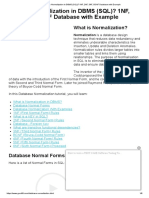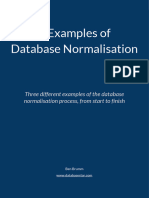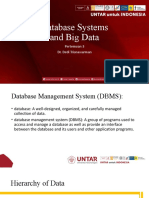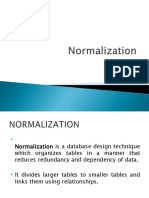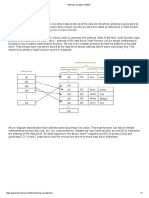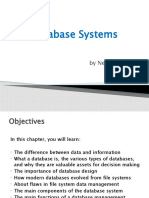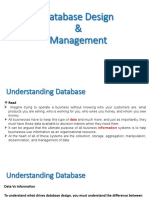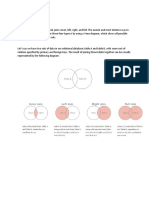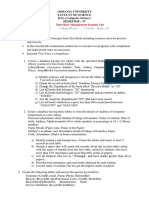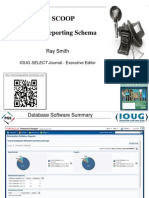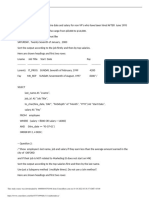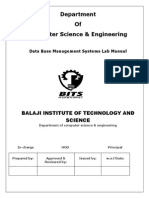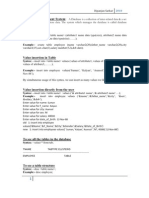0% found this document useful (0 votes)
198 views27 pagesIntroduction To Database Management Systems
The document provides an introduction to Database Management Systems (DBMS), emphasizing the importance of information and data management for organizational success. It outlines the characteristics of data, the organization of databases, and the functions of DBMS, including transaction management, security management, and data catalog management. Additionally, it describes various database users, including end-users, database administrators, and security officers, highlighting their roles in managing and utilizing database systems.
Uploaded by
BSTC153 Vanitha GCopyright
© © All Rights Reserved
We take content rights seriously. If you suspect this is your content, claim it here.
Available Formats
Download as PPTX, PDF, TXT or read online on Scribd
0% found this document useful (0 votes)
198 views27 pagesIntroduction To Database Management Systems
The document provides an introduction to Database Management Systems (DBMS), emphasizing the importance of information and data management for organizational success. It outlines the characteristics of data, the organization of databases, and the functions of DBMS, including transaction management, security management, and data catalog management. Additionally, it describes various database users, including end-users, database administrators, and security officers, highlighting their roles in managing and utilizing database systems.
Uploaded by
BSTC153 Vanitha GCopyright
© © All Rights Reserved
We take content rights seriously. If you suspect this is your content, claim it here.
Available Formats
Download as PPTX, PDF, TXT or read online on Scribd
/ 27
Introduction to
Database Management
Systems
G. VANITHA, MCA., M.Phil,
NET
ASSISTANT PROFESSOR,
DEPARTMENT OF
INFORMATION TECHNOLOGY
BISHOP HEBER COLLEG,
TRICHY-17
Introduction to Database
Management Systems
Introduction
Information
Data & Data Management
File-based data Management
Database Systems
Organizations of database
Characteristics of a data in a database.
Database Management Systems.
Functions of DBMS
Database Users
Introduction
To survive & achieve success,
organizations must exploit the
information-internal & external
better than their competitors.
Information is the most important
weapon that will help
organizations to penetrate the
market & beat the competition.
A database together with a
database Management System is
the backbone of an efficient
Information
Information is the backbone of any
organization.
Information is nothing but refined data.
Information is data a meaningful &
useful context, communicated to a
recipient.
3 key attributes of information
Accuracy, Timelines, Relevancy.
Accuracy means the information is free
from mistakes & errors. i.e the
information is free from bias.
Information
Timelines means getting the
information to the recipients within the
needed time frame. Ex. Yesterday’s
newspaper or stock exchange values
are little change.
Relevancy means the use of a piece of
information for a particular person.
Information i.e relevant for one person
might not be relevant for another.
Information processing is the
attainment, storage, organization,
retrieval display & dissemination of
information.
DATA & DATA
MANAGEMENT
Data are raw facts.
Information is data that has been put into a
meaningful & useful context & communicated
to a recipient who uses it to make decisions.
Some important points
Data constitutes the building blocks of
information.
Information is produced by processing data.
It is used to reveal the meaning of data.
Accurate ,relevant & timely information is the
key to good decision –making.
Good decision –making is the key to
organizational survival in a global
environment.
DATA & DATA MANAGEMENT
A DataBase (DB)is a shared , integrated
computer structure that houses a collection of
end-user-data & metadata(data about data)
The metadata provide a description of the
data characteristics & the set of relationships
that link the data found within the database.
The collection of information stored in a DB at
a particular moment is called an instance of
the database & the overall design of the
database is called the database schema.
A DB resembles a very well-organized
electronic filling cabinet in which powerful s/w
knows DBMS.
FILE –BASED DATA MANAGEMENT
Data Management was done using file-
based systems. The first computer
applications focused on clerical tasks:
order/entry processing ,payroll, work
scheduling etc.
Report generation of file system can be
slow & cumbersome.
The Database Administrator(DBA) &
programmers were the members of this
department & their primary activity was
to meet the information requirements of
the organization.
DISADVANTAGES OF FILE SYSTEMS
Information compartmentalization , where
each department of the organization will
have its own data management system no
synchronized with other department.
The file based system has structural
dependency.
File system is dependent on the
data(Basicpay)
Data redundancy(same information stored
in more than one place)
Data inconsistency. Need programming &
skilled personals, Lack of data security.
Flat-File
DATABASE SYSTEMS
A collection of data designed to be used
by different people is called a database.
It is a collection of interrelated data
stored together with controlled
redundancy to serve one to more
applications in an optimal fashion.
Traditional databases are organized by
fields, records & files.
A field is a single piece of information.
A record is one complete set of fields.
A file is a collection of records.
Ex. Telephone book-is a file, a list of
DATABASE SYSTEMS
WHY A DATABASE?
The advantages of having the data in
database are summarized
Redundancy can be reduced-repeated info
Inconsistency can be avoided-remove
inconsistency(2 entries in the same data)
Data can be shared-share the data in DB.
Standards can be enforced-DBA can
enforce standards.
Security restrictions can be applied-DBA
can define authorization checks.
Integrity can be maintained-the data in the
DB is accurate.Conflicting requirements
can be balanced –overall requirements
helps designers in creating a db design i.e
ORGANIZATION OF A DATABASE
A database consists of 4 elements- data,
relationships, constraints & schema.
Data are binary computer representations of
stored logical entities.
They are distinct pieces of information,
usually formatted in a special way .data is
the plural of datum-a single piece of
information.
Data Dictionary is a file that defines the basic
organization of a database. It contains a list
of all files in the DB, the no.of records in each
file, & the names & types of each field.
ORGANIZATION OF A DATABASE
In DBMS, data files are the files that store
the db information, whereas other files,
such as index files & data dictionaries ,
store administrative information known as
metadata.
Relationships represent a correspondence
between the various data elements.
Constrains are predicates that define
correct database states.
Schema describes the organization of
data & relationships within the database.
ORGANIZATION OF A DATABASE
The schema defines various views of the
database for the use of components of the
DBMS& for the application security.
The internal schema defines now & where
data are organized in physical data
storage.
The conceptual schema defines the stored
data structures in terms of the DB model
used.
The external schema defines a view or
views of the database for particular users.
ORGANIZATION OF A DATABASE
CHARACTERISTICS OF DATA
IN DATABASE (features)
Shared:-shared among different
users & applications.
Persistence: -the data can live
beyond the scope of the process
that created it.
Validity/Integrity/Correctness: -
data should be correct with
respect to the real world entity
that they represent.
Security:-data should be
CHARACTERISTICS OF DATA IN
DATABASE (features)
Consistency:-more than one data
element in a db represents
related real-world values.
Non-redundancy:-no two data
items in a db should represent
the real-world entity.
Independence:- the 3 levels in
the schema should be
independent of each other,
changes in one schema it will not
DATABASE MANAGEMENT SYSTEMS
A DBMS is a collection of a programs that
manages the db structure & controls access
to the data stored in the db.
It is a collection of programs that enables you
to modify, store & extract information from db.
There are different types of DBMS’s.
Ex. Of DBMS Applications
Computerized library systems
Automated Teller Machine(ATM)
Flight reservation systems
Computerized parts inventory systems
Enterprise Resource Management(ERP)
systems
FUNCTIONS OF DBMS
A DBMS is a piece of s/w that provides services
for accessing a database.
Transaction Management: a sequence of db
operations represents a logical unit of work.
A transaction can update or delete a record,
modify a set of records of records.
commit:.the changes made by the transaction
are made permanent.
rollback:the transaction & the db will remain in its
original stage
Concurrency Control: coordinating the actions of
db manipulation processes that operate
concurrently & access shared data thus
interfering with one another.
FUNCTIONS OF DBMS
Recovery Management: it ensures that the
aborted or failed transactions create no
adverse effects on the db or other
transactions.
Security Management: the protection of data
against unauthorized access. it depends
privileges of the users.
Language Interface: the DBMS provided
languages for the definition & manipulation
of data in the database. Created using Data
Definition commands. Manipulation done by
data manipulation commands.
FUNCTIONS OF DBMS
Storage Management:DBMS provides a
Permanent storage of the data.the internal
schema defines how the data should be
stored by the storage management
mechanism & the storage manager
interfaces with the OS to access the physical
storage.
Data Catalog Management: data catalog or
data dictionary is a system db that
constrains descriptions of the data in the
db(metadata).it contains info/. about data,
relationships, constraints & the entire
schema.
DATABASE USERS
End –users are people who use the
information stored in the database for a
variety of purposes including decision-
making.
Support personnel: are the people who
manage the db’s ,control the access, handle
the security & performance issues ,create,
delete & maintain the db objects.
Database Administrator(DBA):central control
over data & programs accessing the data.
he is responsible for authoriaing access to
the db, coordinating & monitoring its use &
acquiring s/w & h/w resources as needed.
DATABASE USERS
DATABASE USERS
Database Designers: responsible for
identifying the data to be stored in the db &
choosing the appropriate structures to
represent & store this data. He interact with
user to satisfy the user needs.
End-users: it can be application
programmers , application programs,
managers, data entry operators.
System administrator: is the person
responsible for the entire computer system
of the organization, who has control over the
various applications, programs, db’s & other
s/w & h/w resources of the organization.
DATABASE USERS
Security Officers: today databases & db
applications are increasing in size,
complexity & capabilities. Db is sensitive &
to prevent unauthorized access, corruption
& destruction. whole sole responsibility is
protecting data from unauthorized access.
Network Administrators: to manage the
networks & to ensure that all the users of
the db have access to the data the n/w
administrators have to work closely with
the DBA & security officers.








